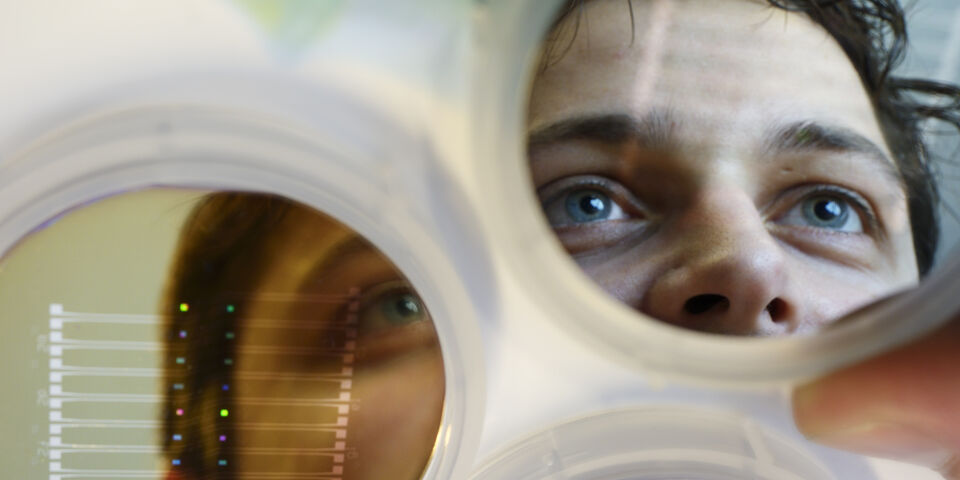Brown’s budging pellets
Researchers at Molecular Materials and Nanosystems (M2N) had already proven that smartly designed electrodes can be used to propel electrons highly energy-efficiently. Doctoral candidate Wijnans Germs of M2N studied the concept of the ‘electronic ratchet’ as a way to separate plastic nano-pellets by size, a method that might be useful for medical self-testing kits.
When Robert Brown was peering through his microscope studying pollen grains back in 1827, the Scottish botanist noticed unexpected movements: tiny particles from the pollen grains moved about through the water quite haphazardly, as if propelled by invisible forces. This Brownian motion later turned out to be the result from particles continually colliding with water molecules. In 1905, Albert Einstein showed that Brownian motion may even be used to predict size, mass, and number of these water molecules, and he so indirectly proved the existence of molecules.
Watching the energetic Brownian motion, you might think you’re on to something: what if it’s possible to generate energy with the help of some kind of paddlewheel powered by Brown’s moving particles? Should the wheel be equipped with a ratchet system making it spin one way only, it could be useful. Unfortunately, the possibility of a Brownian ratchet goes against the second law of thermodynamics: you can’t draw energy from a system in thermodynamic equilibrium – ‘there’s no such thing as a free lunch’ does not only apply to economics.
Since there’s no way around the second law of thermodynamics, it’s principally impossible to develop a working ratchet so small in size it can be powered by the Brownian motion, unfortunately. Still, that doesn’t mean Brownian motion is entirely useless, says doctoral candidate Wijnand Germs. “If you unbalance a system by adding energy, the Brownian motion can most certainly be used for a type of ratchet system.”
Germs researched a method based on Brownian motion to separate tiny plastic pellets by size. Such a separation method could be useful in labs-on-a-chip, devices that enable the immediate analysis of blood, saliva, or urine. A well-known application is the blood sample self-test patients can use to measure their blood sugar level. “In order to measure specific proteins with a lab-on-a-chip, you can coat tiny plastic pellets with antibodies. The proteins you’re looking for will cling to the pellets. Separating the pellets bearing several types of proteins is no picnic, though.”
One possible solution may be using pellets of various sizes. The smaller the pellets, the faster their Brownian motion – smaller pellets are simply more easily affected by water molecules bumping into them. If the Brownian motion can be forced in a certain direction, the smaller pellets will eventually break free from the larger ones, much like climbing specialists in the Tour de France break away from the peloton in an uphill stage. “Selecting nanoparticles based on their size is of importance in other uses as well”, Germs stresses. “The characteristics of these particles depend on their size, after all.”
In a lab-on-a-chip, the plastic pellets are located in a microchannel filled with fluid, so their movement is already restricted to back or forth only. Now it was thought if the pellets were electrically charged, they could be manipulated by electric fields. “Electrically charged pellets can be pulled in any desired direction using a electric field; the smaller particles will move faster then, too”, Germs says. “Unfortunately, that method requires high voltage on a very small surface area, and that’s just not practical.”


Discussion